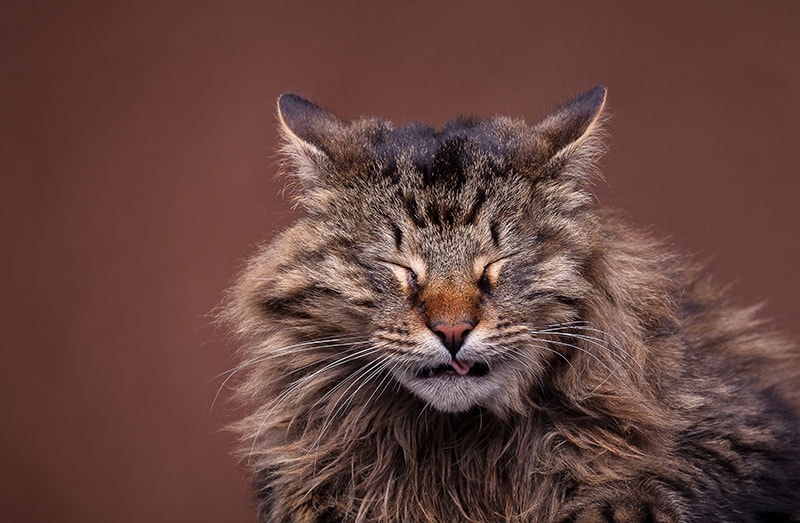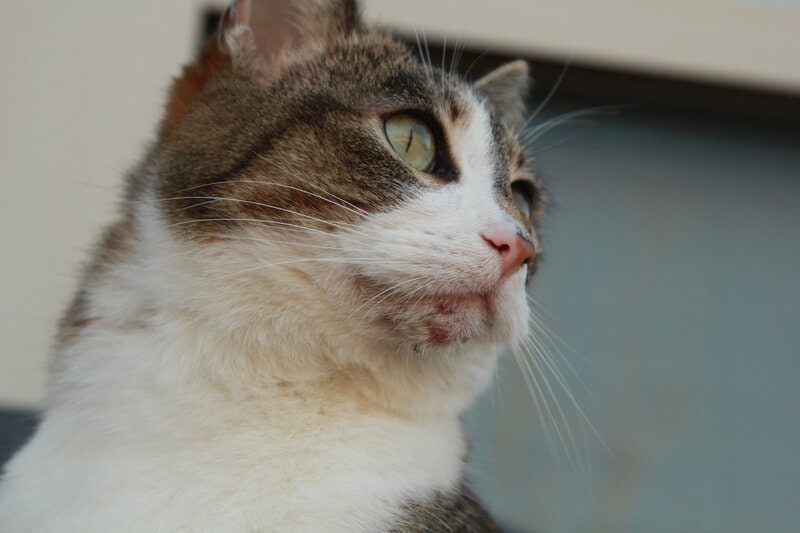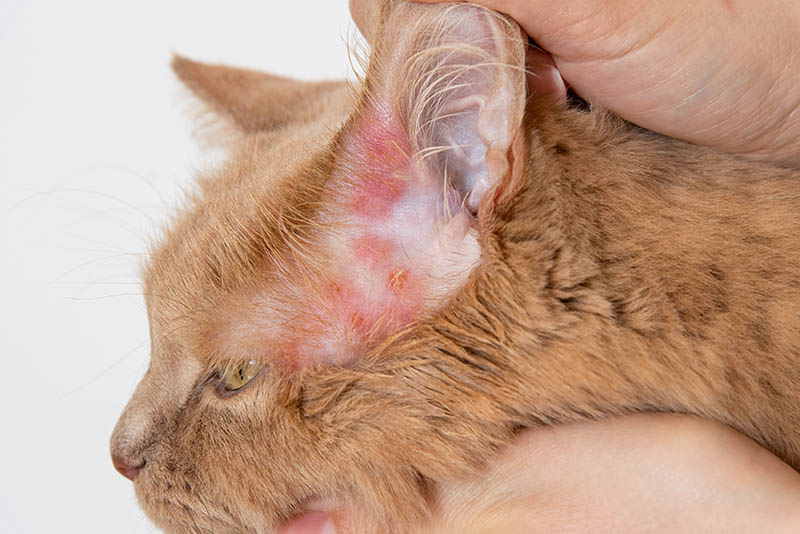Why Is My Cat Losing Whiskers? 4 Possible Reasons (Vet Answer)

Updated on

It’s no surprise that we refer to anything highly admired as “the cat’s whiskers.” Not only do these special hairs enhance a cat’s face, but whiskers also serve an important purpose. It is normal to be concerned if your beloved cat suddenly starts to lose its whiskers.
Finding the odd whisker or two around the house from time to time is perfectly normal—a lost whisker will grow back. However, if your cat suddenly starts losing an excessive amount of whiskers, it could indicate that something is wrong.
The 4 Reasons Why Cats Lose Whiskers
Just as cats shed fur, they also shed their whiskers. This is because a cat’s whiskers are a special type of hair and go through a normal cycle of growth, dormancy, and shedding. However, whiskers are not shed nearly as often as fur. Just like fur, whiskers that are lost during the normal process of shedding will regrow. Cats usually only lose one or two whiskers at a time, and it’s likely that this normal whisker loss will go by unnoticed.
Whisker shedding becomes an issue if it becomes excessive or is accompanied by hair loss or skin issues such as flaking, oozing, or inflammation. Apart from the normal process of shedding, a cat may lose its whiskers due to allergies, infections, or feline acne. Trauma or physical damage to the whiskers may also result in whisker loss.
1. Allergies
Allergies can cause a cat to develop intense facial itching. In an attempt to relieve the irritation, an itchy cat may rub its face against an object or scratch at its face with a paw. This may result in blunt or broken whiskers.
Cats suffer from three main types of allergies: environmental allergies, food hypersensitivities, and allergies to parasites. If your cat starts to groom, rub, or scratch excessively, or starts to lose its hair or whiskers, you should get them checked by a veterinarian. Once your veterinarian has determined exactly what your cat is allergic to, treatment is aimed at avoiding the allergen if possible.
This may involve cutting out certain types of food in the case of food allergies and keeping your cat’s parasite treatment up to date in the case of parasite allergies. Environmental allergens are unfortunately harder to avoid. Your vet may also recommend a special diet, special shampoos, and ointments, or prescribe medication, such as corticosteroids, for a short period of time to help relieve the itch.
Whiskers lost as a result of allergies will grow back once the allergy is under control.

2. Infections
Bacterial, fungal, or parasitic skin infections can all cause a cat to lose its hair. If a cat develops a skin infection in the same area as its whiskers, the whiskers may be lost along with the coat.
As with allergies, these infections can be extremely itchy, and the whiskers and surrounding fur may be scratched or broken off by excessive rubbing or scratching as the cat attempts to stop the itch. The hair shaft or the follicle may also become infected.
Ringworm—which is a type of fungus and not a worm—infects the hair shaft directly. As a result, the whisker or hair becomes more fragile and breaks easily, leaving a bald patch. Bacterial, fungal, and parasitic infections may also affect the hair follicle and cause folliculitis. Hairs and whiskers with infected follicles fall out more easily than healthy hairs.
Hair and whisker loss from skin infections is also accompanied by oozing, crusting, flaking, and inflammation of the skin. If you notice any of these signs, it is important that you get your cat checked by a veterinarian. Your vet may want to take samples from the affected areas in order to determine the type of infection that your cat is suffering from.
The treatment for bacterial, fungal, and parasitic infections varies depending on the type of infection present and may include oral or injectable medications, special shampoos, and ointments. Your cat’s whiskers should grow back once the infection is gone.
If you need to speak with a vet right now but can’t get to one, head over to JustAnswer. It’s an online service where you can talk to a vet in real time and get the personalized advice you need for your pet — all at an affordable price!
3. Feline Acne
Feline acne is caused by the overproduction of keratine and the overactivity of the sebaceous glands. Most sebaceous glands are associated with hair follicles. These glands produce an oily secretion called sebum which waterproofs the coat, keeps the skin supple, and plays a role in scent marking. There are many sebaceous glands located on the chin and the lips of a cat, and this is why you will often see your cat rub its chin and lips against objects to mark them with its scent. You may even be marked by your cat when returning home.
Excessive sebum or keratine production can result in these glands becoming blocked. This, in turn, results in comedones, commonly known as blackheads. The fur in the affected area appears greasy and has small flecks of black material in it. The chin is the most commonly affected area but the lips may also be affected. In severe cases, a secondary bacterial infection may lead to folliculitis and pyoderma or deep skin infection of the chin and lips.
As described in the section above, hairs and whiskers with infected follicles fall out more easily than healthy hairs. These infections are also uncomfortable and itchy and whiskers may be lost through self-trauma.
Cats showing any of these signs should be checked by a vet. If your cat is diagnosed with feline acne, treatment usually involves special shampoos or ointments aimed to remove excess sebum and oral antibiotics if a secondary infection is present. Plastic bowls have been implicated in cases of feline acne, as some cats are allergic to plastic and plastic can also harbor bacteria. Switching to feeding your cat from a metal or ceramic bowl may be beneficial if your cat is suffering from feline acne.
Whiskers and fur lost as a result of feline acne will grow back once the condition has been resolved.

4. Trauma or Physical Damage to the Whiskers
A cat’s whiskers may break off during a fight with another cat. This is especially true if your cat is allowed outside access since catfights are common in free-roaming felines. Cats within the same household may also break whiskers during vigorous play.
Another way in which a cat may lose its whiskers from trauma is if it gets too close to a fire, stove, or another heat source and singes its whiskers. The remaining ends of singed whiskers usually have a curled appearance.
If a cat’s whiskers appear to be cleanly sheared, it is possible that a naughty child may have trimmed the whiskers!
Unless your cat is injured as a result of the trauma or physical damage to its whiskers, there is no need to worry, as these whiskers will grow back without intervention.
What Are Whiskers and What Function Do They Serve?

Whiskers are a special kind of hair. The technical name for these long, thick, stiff hairs is “vibrissae,” which comes from the Latin word “vibrio,” which means to vibrate.
These special hairs are thicker, stiffer, and longer than normal hairs and are embedded three times deeper in the skin. The follicles at the base of the whisker are packed with nerve endings.
Despite being called “tactile hairs,” whiskers themselves don’t actually feel anything. Instead, they pick up vibrations from changing air currents or when they brush up against objects. These vibrations are transmitted to proprioceptors at the end of each whisker. The proprioceptors, in turn, transmit information to the nerve endings at the base of the whisker follicle. This information is then transmitted via the nervous system to the brain, where it is processed.
In this way, whiskers help a cat navigate its environment. A cat’s eyes can’t focus on things less than 12 inches away, so their whiskers are especially important in navigating and providing information about close-up objects.
By detecting changes in air currents, cats may sense that someone or something is approaching, making them more efficient hunters and helping them to avoid predators. Whiskers are generally as wide as a cat’s body and help a cat determine whether or not it can fit through a narrow gap, although this is not always true for overweight cats.
Did you know that in addition to having whiskers on their upper lips, cats also have whiskers above their eyes, chin, and at the back of their forelimbs? These special hairs also provide insight into a cat’s mood. It is possible to tell from the position of the whiskers whether a cat is relaxed, interested, fearful, aggressive, or in pain.
Without its whiskers, a cat may be less adept at navigating its environment and may get stuck in small spaces.
Final Thoughts
It’s normal for your cat to lose one or two whiskers from time to time. Whiskers lost due to natural shedding will regrow, and the loss of one or two whiskers will not negatively affect your cat’s ability to navigate its environment. If your cat loses an excessive amount of whiskers or if whisker loss is accompanied by fur loss or an abnormality with the skin, it is best to get your cat checked by a vet since it may be a sign of an underlying issue.
See also:
- Why Does My Cat Hide? 3 Likely Reasons (Vet Answer)
- Why Are My Cat’s Whiskers So Short? 7 Vet Reviewed Reasons
Featured Image Credit: slidesl, Shutterstock













